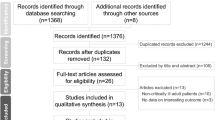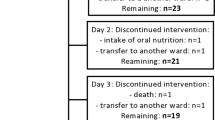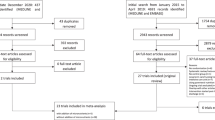Abstract
Objective:
Studies suggest clinical benefit of glutamine-supplemented parenteral nutrition. The aim was to determine if the inclusion of 10 g of glutamine as part of the nitrogen source of home parenteral nutrition (HPN) reduces infectious complications.
Subjects/Methods:
Thirty-five patients on HPN were recruited and 22 completed the study. Patients were randomized to receive either standard HPN or glutamine-supplemented HPN. Patients were assessed at randomization, 3 and 6 months later then they were crossed over to the alternative HPN and reassessed at 3 and 6 months. Assessments included plasma amino acid concentrations, intestinal permeability and absorption, nutritional status, oral and parenteral intake, quality of life, routine biochemistry and haematology.
Results:
No difference was seen between the groups at randomization. No difference was detected between the treatment phases for infective complications (55% in the standard treatment phase and 36% in the glutamine-supplemented phase P=0.67). There were no differences in nutritional status, intestinal permeability, plasma glutamine concentrations or quality of life.
Conclusion:
Although limited by the sample size, the study has shown that glutamine as part of the nitrogen source of parenteral nutrition can be given to patients on HPN for 6 months without any adverse effects.
This is a preview of subscription content, access via your institution
Access options
Subscribe to this journal
Receive 12 print issues and online access
$259.00 per year
only $21.58 per issue
Buy this article
- Purchase on Springer Link
- Instant access to full article PDF
Prices may be subject to local taxes which are calculated during checkout


Similar content being viewed by others
References
Buchman A (2001). Glutamine: commercially essential or conditionally essential? A critical appraisal of the human data. Am J Clin Nutr 74, 25–32.
Calder PC (1994). Glutamine and the immune system. Clin Nutr 13, 1–8.
D'Antiga L, Dhawan A, Davenport M, Mieli-Vergani G, Bjarnason I (1999). Intestinal absorption and permeability in paediatric short-bowel syndrome: a pilot study. J Pediatr Gastroenterol Nutr 29, 588–593.
Detsky AS, McLaughlin JR, Abrams HB, L'Abbe KA, Whitwell J, Bombardier C et al. (1986). Quality of life of patients on long-term total parenteral nutrition at home. J Gen Intern Med 1, 26–33.
Dolan P, Gudex C, Kind P, Williams A (1995). A Social Tariff for EuroQol: Results from a UK General Population Survey. Centre for health economics: University of York, York.
Garcia-de-Lorenzo A, Zarazaga A, Garcia-Luna PP, Gonzalez-Huix F, Lopez-Martinez J, Mijan A et al. (2003). Clinical evidence for enteral nutritional support with glutamine: a systematic review. Nutrition 19, 807–811.
Griffiths RD, Jones C, Palmer TEA (1997). Six-month outcome of critically ill patients given glutamine-supplemented parenteral nutrition. Nutrition 13, 295–302.
Gurney JM, Jelliffe DB (1973). Arm anthropometry in nutritional assessment: nomogram for rapid calculation of muscle circumference and cross sectional muscle and fat areas. Am J Clin Nutr 26, 912–915.
Hammarqvist F, Wernerman J, Ali R, von der Decken A, Vinnars E (1989). Addition of glutamine to total parenteral nutrition after elective abdominal surgery spares free glutamine in muscle, counteracts the fall in muscle protein synthesis, and improves nitrogen balance. Ann Surg 209, 455–461.
Heyland D, Dhaliwal R, Drover JW, Gramlich L, Dodek P (2003). Canadian Clinical Practice Guidelines for nutrition support in mechanically ventilated, critically ill adult patients. J Parenter Enteral Nutr 27, 355–373.
Hornsby-Lewis L, Shike M, Brown P, Klang M, Pearlstone D, Brennan M (1994). L-Glutamine supplementation in home total parenteral nutrition patients: stability, safety, and effects on intestinal absorption. J Parenter Enteral Nutr 18, 268–273.
Jeppesen PB, Langholz E, Mortensen PB (1999). Quality of life in patients receiving home parenteral nutrition. Gut 44, 844–852.
Kingsland PA, Kingsnorth A, Royle GT, Kettlewell MGW, Ross BD (1981). Glutamate metabolism in malnutrition and sepsis in man. Br J Surg 68, 234–237.
Krebs HA (1935). Metabolism of amino acids. IV. The synthesis of glutamine from glutamic acid and ammonia and the enzymatic hydrolysis of glutamine in animal tissues. Biochem J 33, 1951–1969.
McAndrew HF, Lloyd DA, Rintala R, van Saene HK (1999). Intravenous glutamine or short-chain fatty acids reduce central venous catheter infection in a model of total parenteral nutrition. J Pediatr Surg 34, 281–285.
Menzies IS, Crane R (1998). Assessing intestinal absorptive capacity and permeability in vivoIn: Preedy VR, Watson RR (eds). Methods in Disease: Investigating the Gastrointestinal Tract. Greenwich Medical Media: Londonpp 41–63.
Morlion BJ, Stehle P, Wachtler P, Siedhoff HP, Koller M, Konig W et al. (1998). Total parenteral nutrition with glutamine dipeptide after major abdominal surgery. Ann Surg 227, 302–308.
Nelson M, Atkinson M, Meyer J (1997). A Photographic Atlas of Food Portion Sizes. MAFF: London.
Novak F, Heyland DK, Avenell A, Drover JW, Su X (2002). Glutamine supplementation in serious illness: a systematic review of the evidence. Crit Care Med 30, 2022–2029.
O'Keefe SJ, Burnes JU, Thompson RL (1994). Recurrent sepsis in home parenteral nutrition patients: an analysis of risk factors. J Parenter Enteral Nutr 18, 256–263.
O'Riordan MG, Fearon KCH, Ross JA, Rogers P, Falconer JS, Bartolo DCC et al. (1994). Glutamine-supplemented total parenteral nutrition enhances T-lymphocyte response in surgical patients undergoing colorectal resection. Ann Surg 220, 212–221.
Ockenga J, Borchert K, Stüber E, Lochs H, Manns MP, Bischoff SC (2005). Glutamine enriched total parenteral nutrition in patients with inflammatory bowel disease. Eur J Clin Nutr 59, 1302–1309.
Ogle CK, Ogle JD, Mao JX, Simon J, Noel JG, Li BG et al. (1994). Effect of glutamine on phagocytosis and bacterial killing by normal and paediatric burn patient neutrophils. J Parenter Enteral Nutr 18, 128–133.
Richards DM, Scott NA, Shaffer JL, Irving M (1997). Opiate and sedative dependence predicts a poor outcome for patients receiving home parenteral nutrition. J Parenter Enteral Nutr 21, 336–338.
Rose WC (1938). The nutritive significance of the amino acids. Physiol Rev 18, 109–136.
Sherwood RA (1990). Amino acid measurements by high-performance liquid chromatography using electrochemical detection. J Neurosci Methods 34, 17–22.
van Acker BAC, Hulsewe KWE, Wagenmakers AJM, von Meyenfeldt MF, Soeters PB (2000). Response of glutamine metabolism to glutamine-supplemented parenteral nutrition. Am J Clin Nutr 72, 790–795.
van der Hulst RR, van Kreel BK, von Meyenfeldt MF, Brummer RJM, Arends JW, Deutz NEP et al. (1993). Glutamine and the preservation of gut integrity. Lancet 341, 1363–1365.
Ware J (1993). SF-36 Health Survey, Manual and Interpretation Guide. Medical Outcomes Trust: Boston.
Windmueller HG (1982). Glutamine utilization by the small intestine. Adv Enzym Relat Areas Mol Biol 53, 201–237.
Young LS, Bye R, Scheltinga M, Ziegler TR, Jacobs DO, Wilmore DW (1993). Patients receiving glutamine-supplemented intravenous feedings report an improvement in mood. J Parenter Enteral Nutr 17, 422–427.
Ziegler TR, Benfell K, Smith RJ, Young LS, Brown E, Ferrari-Baliviera E et al. (1990). Safety and metabolic effects of L-glutamine administration in humans. J Parenter Enteral Nutr 14 (Suppl 4), 137S–146S.
Ziegler TR, Young LS, Benfell K, Scheltinga M, Hortos K, Bye R et al. (1992). Clinical and metabolic efficacy of glutamine supplemented parenteral nutrition after bone marrow transplantation. Ann Intern Med 116, 821–828.
Acknowledgements
Financial support of this investigation in the form of an unrestricted grant from Fresenius Kabi is gratefully acknowledged. Claire Chadwick and Shola Olusanya, Department of Pharmacy at St Mark's, are thanked for performing the randomization and crossover. We are grateful to Roy Sherwood, Sue Maestranzi and Kate John from King's College Hospital for the amino acid and urinary sugar analyses and to Diane Brundrett for dietetic support. Paul Bassett is thanked for help with statistical analysis.
Author information
Authors and Affiliations
Corresponding author
Additional information
Contributors: AC was the study lead and involved in recruitment, data collection, blood and urine sample collection and preparation, data interpretation and writing the article. SMG was involved in the protocol development, supervision of the data collection and interpretation and writing the article. IB and GG were involved in the protocol development. AF was involved in the protocol development and writing the article. AMM was involved in writing the article.
Rights and permissions
About this article
Cite this article
Culkin, A., Gabe, S., Bjarnason, I. et al. A double-blind, randomized, controlled crossover trial of glutamine supplementation in home parenteral nutrition. Eur J Clin Nutr 62, 575–583 (2008). https://doi.org/10.1038/sj.ejcn.1602754
Received:
Revised:
Accepted:
Published:
Issue Date:
DOI: https://doi.org/10.1038/sj.ejcn.1602754



